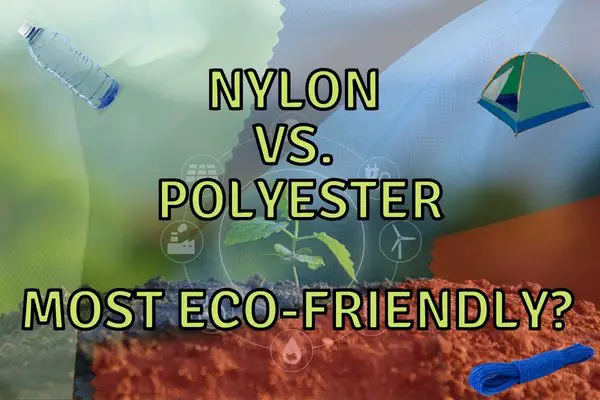Nylon and polyester are not particularly good for the environment. They are made from fossil fuels and both require a lot of energy to produce, use clean water in the process and they both emit harmful pollutants during manufacturing.
Whereas nylon production emits more CO2 to the atmosphere than polyester, polyester manufacturing uses more clean water and polyester fabrics are harder to recycle.
However, both fabrics can be made from recycled materials, but they do (sadly and more commonly) break down into micro plastics in nature due to the costs of recycling.
So if you’re looking for an environmentally friendly fabric option, neither nylon nor polyester is ideal. Some more sustainable options include organic cotton, linen, hemp, and bamboo.
Contents
What Is Nylon And How Is It Made?
Nylon is a synthetic polymer made from petroleum products. It was first developed in 1935 by DuPont chemist Wallace Carothers.
The production of nylon requires large amounts of energy and water, as well as chemicals such as hexamethylenediamine and adipic acid (both derived from petroleum).
Once these raw materials are combined, they undergo a process called polymerization, during which they form long chains that make up the nylon polymer.

Additionally, the manufacturing process for nylon creates hazardous waste that can pollute air and water sources if not properly disposed of.
Key Takeaway: Nylon is a versatile plastic that can be used to make a variety of products. It is made from oil, water, and air, and it is produced through a process of synthesis and polymerization.
The Environmental Impact of Nylon Production
The manufacture of nylon is a complex process that involves several steps and uses a variety of chemicals.
The production of nylon is a significant source of pollution, particularly in terms of the release of carbon dioxide into the atmosphere.
The production of nylon contributes to greenhouse gas emissions and climate change and emits approximately 16 kg of CO₂ per kg of material produced.

Nylon is made from petroleum, which is a non-renewable resource. The production of nylon requires a great deal of energy in the form of heat, and this results in the release of large amounts of CO2 into the atmosphere.
The impact of nylon production on the environment is significant and it is important to consider the environmental impacts of this synthetic fiber when making decisions about what fabrics to use.
Take a look at my recent post if you are interested in the differences between nylon and polyester.
How Is Polyester Produced?
While polyester is often praised for being a durable and strong fabric, it is important to remember that it is made from petroleum-based products.
This means that the production of polyester has a negative impact on the environment.

In order to produce polyester, two types of liquids – ethylene glycol and terephthalic acid – must be combined to form long chains of molecules called polymerization.
The process of polymerization creates long chains of synthetic fabric that make up polyester.
The Environmental Impact of Polyester Production
The use of polyester has increased over the past few decades due to the fabric’s low cost and durability.
But polyester fabrics have a significant environmental impact throughout their life cycle. From production to disposal.
However, the production of polyester has a significant environmental impact. Polyester is made from petroleum, which is a non-renewable resource.
The production of polyester consumes large amounts of energy and emits greenhouse gases into the atmosphere. Additionally, polyester fabrics are not biodegradable.

When disposed of in landfills, polyester fabrics can take hundreds of years to break down. This can lead to pollution and the release of harmful chemicals into the environment.
The production of polyester also contributes to greenhouse gas emissions and climate change and emits approximately 10 kg of CO₂ per kg of material produced.
There are some ways to reduce the environmental impact of polyester production. One way is to recycle polyester fabrics.
Recycling polyester can save energy and resources that would be required to produce new polyester fabric. Another way to reduce the impact of polyester production is to choose fabrics made from recycled polyester.
However, polyester fabrics are not trivial to recycle and the costs are often higher than making them from scratch!
When purchasing polyester fabrics, it is important to consider the environmental impact of the fabric.
However, there are some ways to reduce the impact of polyester production. By recycling polyester fabrics and choosing fabrics made from recycled polyester.
Key Takeaway: Polyester has a significant environmental impact throughout its life cycle, especially when it comes to water usage and recycling.
Is the Production of Nylon or Polyester Worse for the Environment?
Nylon and polyester are both made from fossil fuels. Nylon is more energy consuming to make and therefore produces more CO2, but Polyester Uses More Water.
So, which one is worse for the environment?
The answer isn’t clear cut because it depends on what you value most – carbon emissions or water usage. If you’re concerned about climate change, then nylon is probably the bigger culprit since it emits more greenhouse gases during production.
However, if you worry more about water shortages, then polyester might be the greater environmental concern since its manufacturing process consumes large amounts of water.
In addition to its contribution to climate change, nylon production releases pollutants including carbon monoxide, nitrogen oxides, and sulfur dioxide into the air.
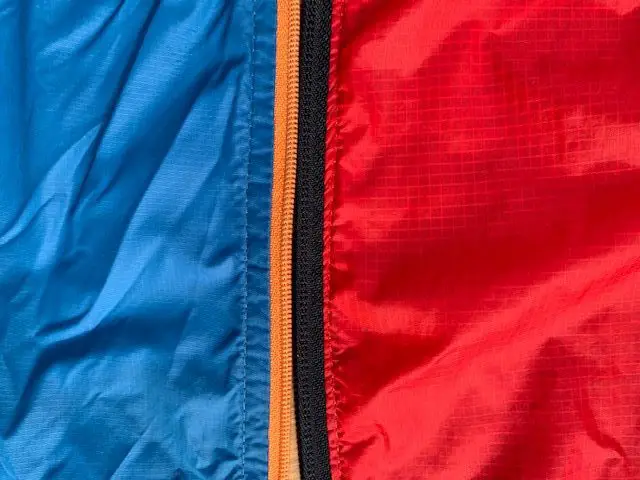
These emissions can lead to smog formation and respiratory problems in humans.
Water pollution is another concern associated with nylon production; effluent from manufacturing plants can contain toxic chemicals that harm aquatic life and contaminate drinking water sources.
If you’re concerned about the environmental impact of your clothing, look for items made from sustainable materials like organic cotton or bamboo. You can also choose secondhand clothing or gear made from nylon.
By making more environmentally conscious choices, you can help reduce the impact of nylon production on the planet.
Key Takeaway: Nylon has a significant environmental impact, from the release of harmful chemicals into the air and water to the depletion of natural resources like petroleum and coal.
Is Nylon or Polyester Easier to Recycle?
Nylon and polyester are two of the most popular types of fabrics used in clothing and other products.
But which one is easier to recycle?

Nylon can also be recycled into new nylon fabric products from other materials, such as carpeting and fishing nets, which is easier to do than for polyester, but more expensive!
Recycling rates for nylon are low due to the higher price than producing new nylon, so most nylon ends up in landfills where it takes centuries to break down.
Polyester is Harder to Recycle So It Is Reused Less
Polyester is a type of plastic made from petroleum. It’s used to make clothing, carpet, and many other things.
Because it’s made from petroleum, it’s not very environmentally friendly. It takes a lot of energy and resources to make polyester, and it can’t be recycled very easily.
When you’re trying to decide whether to buy nylon or polyester, keep in mind that polyester is not very environmentally friendly. It’s made from petroleum, so it takes a lot of energy and resources to produce.
Polyester cannot be recycled very easily into new fabrics but is mostly used for plastic bottles (that end up in the ocean somewhere…), so it’s not a good choice if you’re looking to be eco-friendly.
So, which is better in terms of energy and clean water?
It depends. If you’re looking for a fabric that takes less water to produce and can be recycled into new products more easily, nylon is the better choice.
However, if you’re concerned about your carbon footprint, polyester may be the way to go.
Take care of you nylon or polyester to lower its eco impact
According to a study done by the University of Georgia, it takes about seven years for a piece of nylon or polyester clothing to break down in a landfill.
While that may not seem like a long time, when you compare it to natural fibers like cotton or wool, it is actually quite a bit longer. Natural fibers will break down in just a few months.
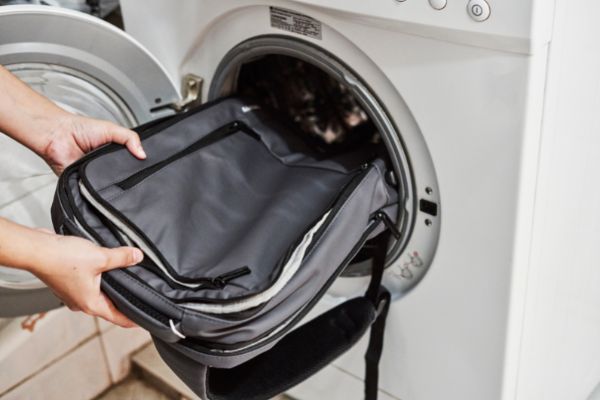
So, while nylon and polyester may not be the most sustainable choice when it comes to fabric, it is still possible to make it last longer by taking proper care of it.
Here are a few tips on how extend the life span of your nylon or polyester fabrics:
- Wash your synthetic clothing in cold water on a gentle cycle.
- Hang your synthetic clothing to dry instead of putting it in the dryer.
- Avoid ironing your synthetic clothing if possible.
- Store your synthetic clothing in a cool, dark place.
- Avoid wearing your synthetic clothing more than necessary.
If you have a nylon or polyester backpack, like those polyester backpacks from JanSport or the Kanken backpack from Fjällräven, then you should follow my guide for drying backpacks to avoid unnecessary wear.
By following these tips, you can help to extend the life of your polyester clothing and make it last longer, which effectively reduces its impact on the environment!
The Environmental Impact Depends on the Source of the Recycled Materials
When it comes to recycled materials, there are two different types of sourcing – pre-consumer and post-consumer. Pre-consumer recycled materials are sourced from manufacturing waste, such as fabric scraps or rejected products.
Post-consumer recycled materials come from items that have been used by consumers and then recycled.
In general, post-consumer recycled materials have a lower environmental impact than pre-consumer recycled materials.
This is because post-consumer recycled materials require few or no additional raw materials to recycle them, whereas pre-consumer recycled materials often require quite a bit of energy to recycle.

Another factor to consider is the type of fabric that the recycled materials come from. Nylon and polyester are both synthetic fabrics, and they can be made from recycled materials.
However, nylon is generally considered to be more environmentally friendly than polyester. This is because nylon is more durable and longer-lasting than polyester, so it doesn’t need to be replaced as often.
Additionally, nylon is easier to recycle than polyester and it can be recycled from fishing nets and old robes.
Most recycled polyester from fabrics end up as PET plastic bottles as it is more demanding to turn it into new fabrics.
So, when it comes to recycled fabrics, nylon is generally better for the environment than polyester. However, the environmental impact of recycled fabrics also depends on the source of the recycled materials.
In general, post-consumer recycled materials have a lower environmental impact than pre-consumer recycled materials.
What Are Alternative Fabrics That Are Better for the Environment?
Sustainable Fabrics. We all know that polyester and nylon aren’t the most environmentally friendly fabrics.
But what are some alternatives?
Wool, down, cotton, hemp, and linen are all great options for those looking for a more sustainable fabric.
Wool
When it comes to sustainability, there are a lot of materials to choose from. But, when it comes to the best material for the environment, wool is a great choice.
Wool is a sustainable and renewable resource. It is biodegradable and recyclable.
Plus, it doesn’t require any harmful chemicals to produce.
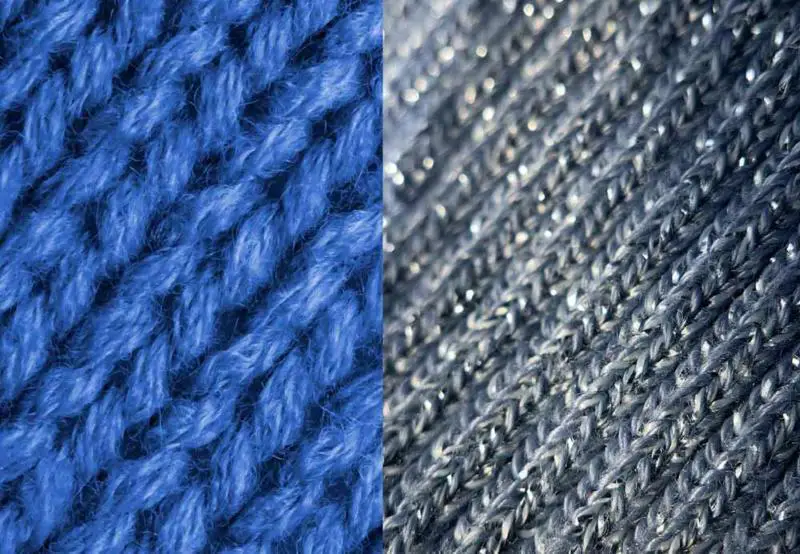
wool is also a natural insulator, meaning it helps to regulate body temperature. This makes it an ideal material for both cold and hot weather.
Read more about the insanely superior properties of wool in my post on cashmere and merino wool here.
Nylon and polyester, on the other hand, are made from petroleum products. They are not renewable and they are not biodegradable.
They also take hundreds of years to break down.
So, when you are trying to be more sustainable, wool is the clear choice. It is better for the environment and it is better for your wardrobe.
Down.
Down is another great option for fill in jackets and sleeping bags. It’s extremely lightweight and insulating, making it perfect for cold weather gear.
And like wool, down is also biodegradable.
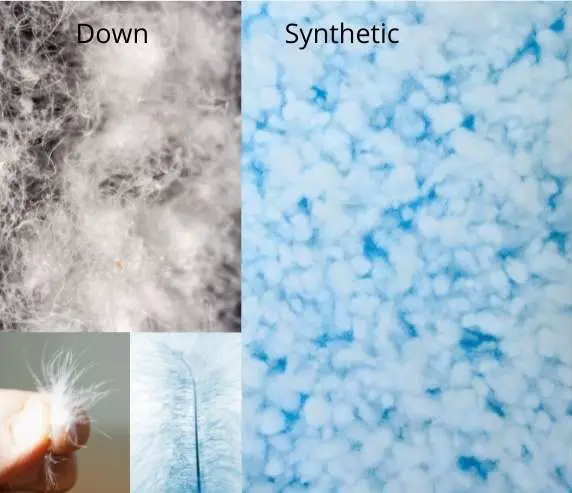
Like wool, down has some really superior properties like really low weight to volume ratios, which makes it the warmest insulator used in outdoor gear.
In fact, the average down is at least 20% warmer than the best polyester filling in outdoor sleeping bags and jackets!
This is why down is the preferred insulation material for lightweight functional down jackets!
Down, is harder to keep functional with time, so remember to store your down gear correctly to avoid the feathers from collapsing!
Cotton
Cotton is perhaps the most well-known sustainable fabric out there.
It’s made from a natural fiber that can be easily grown without the use of pesticides or other harmful chemicals.
However, harsh chemicals are often used when preparing cotton fabrics e.g. to make washed jeans. These chemicals are being replaced with biological solutions (enzymes) that are way less problematic.
Hemp
When it comes to the environment, there are a lot of factors to consider. But one of the most important is the material that you choose for your clothing.
Hemp is a great option for those looking for a more sustainable and eco-friendly fabric.
Hemp is a natural fiber that is grown without the use of pesticides or herbicides. It is also one of the most durable fibers, meaning that your clothes will last longer.
It’s durable, breathable, and UV-resistant. Plus, it requires very little water to grow.
And when it comes to disposal, hemp is completely biodegradable.
So, when you’re considering whether nylon or polyester is better for the environment, remember that hemp is a great option for sustainable, eco-friendly clothing.
Linen.
Linen is a perfect summer fabric.
It’s made from the flax plant, which doesn’t require a lot of water or pesticides to grow. Linen is also biodegradable and recyclable.
So there you have it! Some great alternative fabrics that are better for the environment than polyester and nylon.
FAQs on Nylon and Polyester environmental impact
Is Nylon Considered Environmentally Friendly?
Nylon is not considered an environmentally friendly fabric due to the amount of energy and resources required to produce it. Nylon also emits greenhouse gases during production, which contributes to climate change.
However, nylon can be recycled, so if you do choose to purchase items made from this fabric, look for products that are made from recycled nylon fibers.
Is nylon worse than polyester?
Nylon is not necessarily worse than polyester when it comes to the environment. Both materials are made from petroleum products and have a large carbon footprint.
Nylon does require more energy to produce than polyester, but it is also stronger and more durable and easier to recycle.
Conclusion
Polyester is the more eco-friendly choice between the two fabrics, as it requires less energy and water to produce, and can be recycled into new clothing items.
If you’re looking for a way to enjoy the outdoors while also being eco-friendly, consider investing in some nylon or polyester gear. Both fabrics are produced through processes that have minimal negative impact on the environment, and both can be recycled when you’re done with them.
So next time you head out for a hike, make sure to pack responsibly by choosing products that won’t harm the planet.

